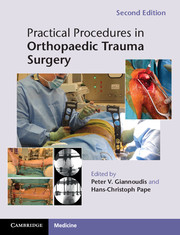Book contents
- Frontmatter
- Dedication
- Contents
- List of Contributors
- Preface
- Acknowledgements
- Part 1 Shoulder girdle
- Part 2 Upper extremity
- Part 3 Pelvis and acetabulum
- Part 4 Lower extremity
- 10 Section I: Extracapsular fractures of the hip
- 11 Section I: Fractures of the femoral shaft
- Section II: Fractures of the distal femur
- 12 Fractures of the patella
- 13 Section I: Fractures of the proximal tibia
- 14 Fractures of the ankle
- 15 Fractures of the foot
- Part 5 Spine
- Part 6 Tendon injuries
- Part 7 Compartments
- Index
Section II: Fractures of the distal femur
Published online by Cambridge University Press: 05 February 2014
- Frontmatter
- Dedication
- Contents
- List of Contributors
- Preface
- Acknowledgements
- Part 1 Shoulder girdle
- Part 2 Upper extremity
- Part 3 Pelvis and acetabulum
- Part 4 Lower extremity
- 10 Section I: Extracapsular fractures of the hip
- 11 Section I: Fractures of the femoral shaft
- Section II: Fractures of the distal femur
- 12 Fractures of the patella
- 13 Section I: Fractures of the proximal tibia
- 14 Fractures of the ankle
- 15 Fractures of the foot
- Part 5 Spine
- Part 6 Tendon injuries
- Part 7 Compartments
- Index
Summary
Introduction
Distal femur fractures are complex injuries. Their aetiology includes high-energy traumas in young patients, often combined with polytrauma or combined fractures (e.g. dashboard injury), and low-energy traumas usually in elderly patients associated with reduced bone quality.
Clinical assessment
Check for pain, swelling, deformity, shortening and intra-articular effusion.
Assess the neurovascular status of the leg and soft tissue damage of closed fractures.
In case of diminished or absent pulse the ankle-brachial indices as well as a Doppler should be done early. In doubt, in case of side-to-side difference, or if a value of less than 0.9 occurs, an arteriogram is indicated.
Open fractures: do not open dressings placed on the scene out of the operating room. Information about local wound findings requires a clear medical handover.
Assess local injury severity with the Abbreviated Injury Scale (AIS) and the total severity of injuries with the Injury Severity Score (ISS).
Check for previous surgery, especially total hip arthroplasty (THA) and total knee arthroplasty (TKA).
Be aware of typically associated injuries: calcaneus, proximal tibia fracture, patella fracture, ligament ruptures of the knee (posterior cruciate ligament), femoral neck fracture, femoral head fracture, acetabulum fracture.
- Type
- Chapter
- Information
- Practical Procedures in Orthopaedic Trauma Surgery , pp. 300 - 320Publisher: Cambridge University PressPrint publication year: 2014



